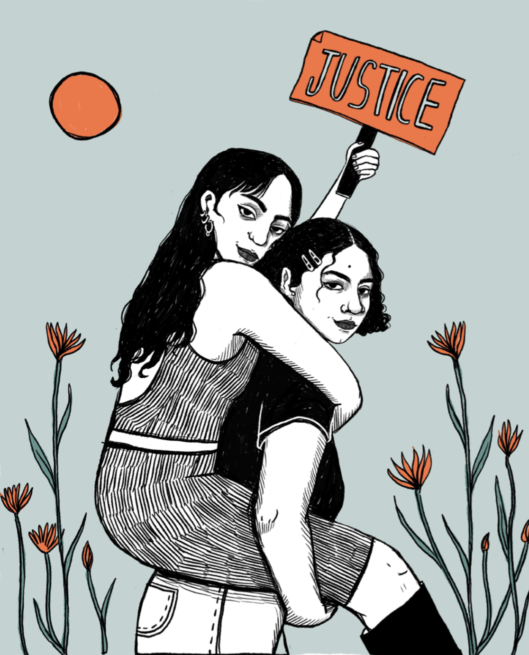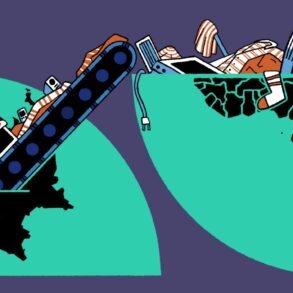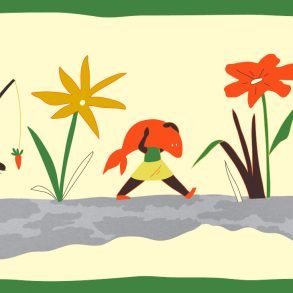“I feel embarrassed when I say feminism and people do not think in service of every living thing.” – Lola Olufemi
3 March 2022: this date marked one year since Sarah Everard was kidnapped, raped, and murdered by a Metropolitan police officer in London. Wayne Couzens was known to the force for his engagement in homophobic, racist and misogynistic messages shared within a WhatsApp group with other officers, and in the months after Sarah’s murder, it was revealed that he had also been responsible for indecent exposure in 2015.
In his time at the Civil Nuclear Constabulary, his colleagues nicknamed him “the rapist”.
UK media has since featured numerous stories uncovering accounts of institutional misogyny and racism in the Met Police and photos covering the front pages of tabloids sparked outrage at the violent police repression of women holding a vigil in the wake of Sarah’s death.
A year after the vigil, feminist direct action group Sisters Uncut set off 1000 rape alarms at Charing Cross Police Station, whilst women gathered to shut down the embankment with banners reading: “Police Are the Perpetrators” and “No Killers, No Cops, Sisters Run The Block”.
Though these events have led to an increasing number of women becoming disillusioned with the police, the consequences that followed Sarah’s death were far too familiar: instead of tackling the systemic and systematic violence in the system, the Government made a dystopian promise of increased police presence.
Blood on their hands
Sarah Everard died because the police do not exist to keep women safe. The reality is that policing is more likely to inflict or perpetuate harm, rather than prevent it. However, the state told us a different story. Spoiler alert: the abuse of power was treated as exceptional, not inevitable. The police remained the ‘good guys.’
But while state protection of abusive powers remains constant, the environment in which it occurs is rapidly changing. What exactly does this violence mean on an ever-warming planet?
Why should we talk about violence, misogyny and the police in the same breath as climate change, environmental injustice and land degradation?
I am trying to show that we can, and should, understand Sarah Everard’s murder as one event on a continuum of violence. Across the world, we mourn the women whose fates follow a repetitive and familiar trajectory. In order to stop this cycle, we must acknowledge the persistence of these murders in a context of structural state violence, inseparable from and embedded within the extractive nature of patriarchal, colonial, and ecological oppression.
Women, when extracted from their homes, their communities, families and friends, routinely and frequently disappear after an interaction with a person of authority. This was the case for Sarah, who was walking home; it’s also the case for the women who defend their homes from state or corporate degradation, or the women who merely dare to exist on the land that was stolen from them.
Angela Davis writes: “the countries that are now experiencing an epidemic of rape are precisely those advanced capitalist countries that face severe economic and social crises and are saturated with violence on all levels … Do men rape because they are men, or are they socialised by their own economic, social, and political oppression – as well as by the overall level of social violence in the country in which they live – to inflict sexual violence on women?”
The UK is facing an epidemic of violence against women, and the actions of Wayne Couzens represent a drop in the ocean. Yet this is about more than one nation state, and more than one rotten institution.
Every crisis is connected
Last year’s vigil for Sarah Everard mirrored vigils held across the US and Canada for Wet’suwet’en or ‘Standing Rock’ political prisoners, or for the vigils that took place for land defenders in Latin America, and the sacred moments people across the world continually hold in mourning for the Earth itself.
These crises are connected. Let us first take the example of ‘man camps’ in North America. ‘Man camps’ are frontiers of resource extraction and displacement, where the men who work in oil, gas, logging and mining industries are given housing whilst they work. These camps often lead to a sudden increase in the frequency of sexual violence, with the victims disproportionately made up of Indigenous women.
Native American women in the US experience a murder rate ten times higher than the national average, and 96% of those who have experienced violence did so at the hands of a non-Native perpetrator.
In addition, rape cases, sex trafficking, and violent assault have been shown to increase once the resource extraction industries’ work begins. An ‘oil boom’ is inextricable from a simultaneous surge of misogynistic and colonial violence. A 2019 report showed that the link between zones of extraction and murdered and missing girls could not be clearer.
Or consider the coup against Evo Morales’ socialist government in Bolivia, reportedly staged in order to extract the lithium needed for an increasing number of consumers in the Global North to have electric battery-powered cars.
During the coup, Bolivian women were taken onto the streets by the military, stripped of their traditional dress, and whipped with said clothing. This didn’t stop CEO of Tesla, Elon Musk, demonstrating just how normalised this violence is with a single tweet: “We will coup whoever we want. Deal with it.”
The Red Nation, a movement for the liberation of Native peoples, argue that the domination over women’s bodies is a tool exercised by the state, its military and its police departments, as a key way to exert dominance over the Earth.

Join our mailing list
Sign up for shado's picks of the week! Dropping in your inbox every Friday, we share news from inside shado + out, plus job listings, event recommendations and actions ✊
Sign up for shado's picks of the week! Dropping in your inbox every Friday, we share news from inside shado + out, plus job listings, event recommendations and actions ✊
Annita Lucchesi is the executive director of the Sovereign Bodies Institute, a research collective that explores gender violence led by Indigenous traditions of data collection and knowledge transfer. She –explains that these industries create a “culture of using and abuse [because]if you can use and abuse the water and land, you can use and abuse the people around you, too.”
If we are rightly unwilling to tolerate patriarchy, then why should we tolerate the suffering of Indigenous peoples and the various manifestations of ecological crises?
One bad apple, or a rotten tree?
In 2020, a viral video showed Chilean Feminist Collective Las Tesis protesting through dance, and a provocative chant: “The rapist is you/It’s the cops/The judges/The state/The President”. It may have begun as a damning critique of Chilean police violence, but there is a reason the performance, the title of which translates to ‘A Rapist in Your Path’, was sung all the way from France, to Mexico, to India. The rhetoric of ‘one bad apple’ has grown tired; women all over the world are demanding that we recognise that this violence is systemic, not simply interpersonal.
For Indigenous women, the reality that the police could never keep them safe predates any widespread notion of this in Britain’s public imagination. Similarly, for many marginalised groups in the UK, the police have never been a symbol of safety, whether or not police violence made headlines.
Humiliation is a tactic of police officers everywhere. The police ally themselves with the people they protect – the state and the industries that propel us towards ecological breakdown.
In New Mexico, Sante Fe police claimed that keeping a toll of missing or murdered Native American women and girls was “too hard” because they had “Spanish names.” While in the UK, Police watchdog, Netpol, published a report on Extinction Rebellion’s “autumn rebellion”, which features reports of incidents such as Met police officers touching women protestors “inappropriately”, including one woman who reported having an officer play with her hair whilst she was in handcuffs.
Police intimidation can be passive, in the racist assumptions and lack of action on missing and murdered women, or it can be direct, in acts of humiliation as subtle as violating women who are handcuffed and under their control, or as extreme as the “extraordinary” police violence suffered by those protesting a pipeline construction on their sacred lands at Standing Rock, in between North and South Dakota.
‘The Red Deal’, an Indigenous guide or ‘toolkit’ for environmental justice, and a decolonial take on the Green New Deal, explains: “Indigenous bodies stand in the way of access to the land, and because women are seen as the producers of Native nations through the European heteropatriarchal lens, violence against women, particularly sexual violence, is used as a means of separating Native people from the land.”
Land thus becomes primed for the extractive activities of fossil fuel companies; it becomes a place of untouched nature for tourists to flock to and for colonisers to profit from – or it simply becomes degraded and barren, as there’s no longer a sacred relationship to protect it, no Indigenous knowledge to conserve and care for it.
A feminist world to win
In this way, we might begin to talk about women’s struggle for bodily autonomy as one and the same as the Indigenous struggle for Land Back. We might begin to understand the call to defund the police as a central move towards tackling environmental injustice and protecting women at the same time. We will begin to say ‘no new prisons’ in the same breath as ‘no new pipelines’.
The mainstream feminist movement doesn’t see these things as aligned, and this needs to change.
Feminists shouldn’t accept greater police presence on the streets, nor should they accept new oil fields, gas pipelines or new prison construction, but most importantly, feminists should refuse to engage with these issues as though they are disparate and isolated from one another.
If mainstream feminism stems from the rejection that there is anything natural about the occurrence of sexual violence against our bodies, then why would we accept the ongoing rape and exploitation of the Earth and the colonised people on it?
Feminism’s greatest revolutionary promise is its potential to interweave our struggles. It was the Combahee River Collective that wrote, “Always ally yourself with those on the bottom, on the margins, and at the periphery of the centres of power. And in doing so, you will land yourself at the very centre of some of the most important struggles of our society and our history.”
We can’t be sure of what a life without sexual violence looks like, as we have never known the absence of such a lingering fear. Similarly, for peripheral populations all over the world, the penetration of lands and the theft of the right to subsist has made the emergency of ecological breakdown a constant and unrelenting reality.
The Women’s Strike’s slogan reads ‘It is impossible, that is why it is necessary.’ It is this impossibility that feminists must build towards.
Perhaps building a life without violence looks like the training of security personnel in Rojava that first requires one to read feminist theory before stepping into the role. Maybe it is the ongoing organising of groups like Cradle Community and No More Prisons in supporting the prisoner class, and winning victories against mega-prison construction across the UK.
Perhaps we might urge others to sign up for the summer schools and community education programmes of the Feminist Autonomous Centre for Research, or the newly founded collective, Abolition Feminism for Ending Sexual Violence, who are “actually focused on ending gender violence, in all its forms.” It will take all of these things and more if we are to build an ecologically resilient feminist future.
What does feminism look like on a dying planet? It is the promise of real utopia – the right of every living thing to live and to exist with freedom from violence.
What can you do?
- Read ‘Abolition. Feminism. Now.’ Angela Y. Davis, Gina Dent, Erica Meiners & Beth Richie.
- Read ‘Experiments in Imagining Otherwise’, Lola Olufemi, Hajar Press.
- Read How Chilean performance collective Las Tesis is growing a global feminist movement
- Check out the Abolitionist Futures Reading List 2022
- ‘The Red Deal: Indigenous Action to Save our Earth’, The Red Nation, Common Notions (Order as a Solidarity Package in order to donate “to Indigenous schools, libraries, organisations, infoshops, and community centres chosen by the Red Nation.”)
- Read ‘Policing environmental injustice – embracing abolition of policing’, Andrea Brock and Nathan Stephens-Griffith Undisciplined Environments.
- Watch ‘CAPE: Abolition 101’ Webinar, Community Action on Prison Expansion, Abolitionist Futures
- Listen to ‘Sii-am Hamilton on Respect-Based Futures’, For the Wild Podcast.
- Watch ‘Families First: Honouring the Voices and Stories of Canadian MMIWG2 Families’ Webinar, Sovereign Bodies Institute
- Join the Feminist Centre for Autonomous Research in their Membership Drive.
- Join the mailing list for Abolitionist Futures.
- Donate to Cradle Community to help facilitate their workshops and events.
- Keep up-to-date with Community Action on Prison Expansion and their actions to stop prison construction in the UK.
- Take a look at the Sovereign Bodies Insititute Organising Toolkit for Murdered and Missing Indigenous Women.
- Donate to Critical Resistance to support their community organising for abolition in the US.
- Use the Wet’suwet’en Supporter Toolkit in order to keep up to date with the movement and learn to be an ally through donations, education, fundraising, and solidarity-building.

In the image the artist has wanted to show the concept, to place oneself as the last frontier.







